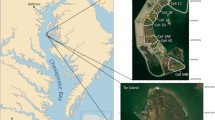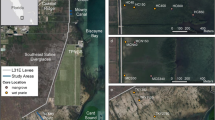Abstract
Salt marshes provide critical ecosystem services and functions including habitat provision and coastal community protection from storms. Chronic disturbances (e.g., anthropogenic inputs, climate change) and episodic disturbances (e.g., storms, oil spills) can affect the species composition and abundances of salt marsh biota, thus influencing ecosystem function and service provision. One such disturbance typical of the northeastern USA is annual nor’easter storms which deposit ice-rafted sediments on the salt marsh surface. In the winter of 2018, however, the extratropical cyclone, winter storm Grayson, deposited sediments equivalent to 15 years of accumulation on portions of the Great Marsh in Ipswich, Massachusetts, USA, potentially causing historic impacts. The recovery of the plant and invertebrate communities were evaluated 3 months, 6 months, and 18 months post ice-rafting from winter storm Grayson. We hypothesized sediment deposits would smother underlying plants, surface-dwelling invertebrates (i.e., epifauna), and surface-feeding infauna, such as polychaetes, although we expected little to no impact to subsurface-feeding infauna, such as oligochaetes. As predicted, plant, epifauna, and surface-feeding infauna were all impacted initially by sediment deposition, with lower abundances in deposits than in references, whereas subsurface-feeding infauna were unaffected. Despite historic volumes of sediment deposited by winter storm Grayson, we saw full recovery of the biotic community within 18 months. Sediment deposits had a maximum thickness of 6.5 cm and were patchily distributed throughout the marsh, and quick revegetation and invertebrate recolonization may ultimately have been from nearby, undisturbed areas. The fast recovery of the biotic community suggests minimal impacts to ecosystem services and functions and indicates an overarching resilience of the salt marsh to natural disturbances such as nor’easters.








Similar content being viewed by others
References
Anderson, M.J. 2001. A new method for non-parametric multivariate analysis of variance. Australian Journal of Ecology 26: 32–46.
Anderson, M.J., K.E. Ellingsen, and B.H. McArdle. 2006. Multivariate dispersion as a measure of beta diversity. Ecology Letters 9: 683–693.
Anderson, M.J., and D.C. Walsh. 2013. PERMANOVA, ANOSIM, and the Mantel test in the face of heterogeneous dispersions: What null hypothesis are you testing? Ecological Monographs 83: 557–574.
Argow, B.A., Z.J. Hughes, and D.M. FitzGerald. 2011. Ice raft formation, sediment load, and theoretical potential for ice-rafted sediment influx on northern coastal wetlands. Continental Shelf Research 31: 1294–1305.
Bell, S.S. 1982. On the population biology and meiofaunal characteristics of Manayunkia aestuarina (Polychaeta: Sabellidae: Fabricinae) from a South Carolina salt marsh. Estuarine, Coastal and Shelf Science 14: 215–221.
Bertness, M.D. and S.C. Pennings. 2000. Spatial variation in process and pattern in salt marsh plant communities in eastern North America. In M.P. Weinstein & D.A. Kreeger (eds) Concepts and controversies in tidal marsh ecology 39–57.
Bick, A. 1996. Reproduction and larval development of Manayunkia aestuarina (Bourne, 1883) (Polychaeta, Sabellidae) in a coastal region of the southern Baltic. Helgolander Meeresuntersuchungen 50: 287–298.
Bulseco, A.N., A.E. Giblin, J. Tucker, A.E. Murphy, J. Sanderman, K. Hiller-Bittrolff, and J.L. Bowen. 2019. Nitrate addition stimulates microbial decomposition of organic matter in salt marsh sediments. Global Change Biology. https://doi.org/10.1111/cb.14726.
Burns, C.J., M. Alber, and C.R. Alexander. 2021. Historical changes in the vegetated area of salt marshes. Estuaries and Coasts. https://doi.org/10.1007/s12237-020-00781-6.
Coleman, D.J., N.K. Ganju, and M.L. Kirwan. 2020. Sediment delivery to a tidal marsh platform is minimized by source decoupling and flux convergence. Journal of Geophysical Research: Earth Surface. https://doi.org/10.1029/2020JF005558.
de Groot, R., L. Brander, S. van der Ploeg, R. Costanza, F. Bernard, L. Braat,M. Christie, N. Crossman, A. Ghermandi, L. Hein, S. Hussain, P. Kumar, A. McVittie, R. Portela, L.C. Rodriguez, P. ten Brink, and P. van Beukering. 2012. Global estimates of the value of ecosystems and their services in monetary units. Ecosystem Services 1: 50–61
Ellison, A.M., M.S. Bank, B.D. Clinton, E.A. Colburn, K. Elliot, C.R. Ford, D.R. Foster, B.D. Kloeppel, J.D. Knoepp, G.M. Lovett, J. Mohan, D.A. Orwig, N.L. Rodenhouse, W.V. Sobczak, K.A. Stinson, J.K. Stone, C.M. Swan, J. Thompson, B. Von Holle, and J.R. Webster. 2005. Loss of foundation species: Consequences for the structure and dynamics of forested ecosystems. Frontiers in Ecology and Environment 3: 479–486.
Ewanchuk, P.J., and M.D. Bertness. 2003. Recovery of a norther New England salt marsh plant community from winter icing. Oecologia 136: 616–626.
Fell, P.E., N.C. Olmstead, E. Carlson, W. Jacob, D. Hitchcock, and G. Silber. 1982. Distribution and abundance of macroinvertebrates on certain Connecticut tidal marshes, with emphasis on dominant molluscs. Estuaries 5: 234–239.
Field, J.G., K.R. Clarke, and R.M. Warwick. 1982. A practical strategy for analysing multispecies distribution patterns. Marine Ecology Progress Series 8: 37–52.
FitzGerald, D.M., Z.J. Hughes, I.Y. Georgiou, S. Black, and A. Novak. 2020. Enhanced, climate-driven sedimentation on salt marshes. Geophysical Research Letters. https://doi.org/10.1029/2019GL086737.
FitzGerald, D.M., C.J. Hein, J.E. Connell, Z.J. Hughes, I.Y. Georgiou, and A.B. Novak. 2021. Largest marsh in New England near a precipice. Geomorphology. https://doi.org/10.1016/j.geomorph.2021.107625.
Friess, D.A., E.S. Yando, I. Alemu, and J.B., Wong, L.W., Soto, S.D., and Bhatia, N. 2020. Ecosystem services and disservices of mangrove forests and salt marshes. Oceanography and Marine Biology: An Annual Review 58: 107–142.
Gedan, K.B., B.R. Silliman, and M.D. Bertness. 2009. Centuries of human-driven change in salt marsh ecosystems. Annual Review in Marine Science 1: 117–141.
Hardwick-Witman, M.N. 1985. Biological consequences of ice rafting in a New England salt marsh community. Journal of Experimental Biology and Ecology. 87: 283–298.
Hill, J.M., P.S. Petraitis, and K.L. Heck. 2020. Submergence, nutrient enrichment, and tropical storm impacts on Spartina alterniflora in the microtidal northern Gulf of Mexico. Marine Ecology Progress Series 644: 33–45.
Hopkinson, C.S., J.T. Morris, S. Fagherazzi, W.M. Wollheim, and P.A. Raymond. 2018. Lateral marsh edge erosion as a source of sediments for vertical marsh accretion. Journal of Geophysical Research: Biogeosciences. https://doi.org/10.1029/2017JG004358.
Jänes, H., P.I. Macreadie, P.S.E. Zu Ermgassen, J.R. Gair, S. Treby, S. Reeves, E. Nicholson, D. Ierodiaconou, and P. Carnell. 2020. Quantifying fisheries enhancement from coastal vegetated ecosystems. Ecosystem Services. https://doi.org/10.1016/j.ecoser.2020.101105.
Johnson, D.S., J.W. Fleeger, K.A. Galván, and E.B. Moser. 2007. Worm holes and their space-time continuum: Spatial and temporal variability of macroinfaunal annelids in a northern New England salt marsh. Estuaries and Coasts 30: 226–237.
Johnson, D.S., and J.W. Fleeger. 2009. Weak response of saltmarsh infauna to ecosystem-wide nutrient enrichment and fish predator reduction: A four-year study. Journal of Experimental Marine Biology and Ecology 373: 35–44.
Johnson, D.S. 2011. High-marsh invertebrates are susceptible to eutrophication. Marine Ecology Progress Series 438: 143–152.
Johnson, D.S., R.S. Warren, L.A. Deegan, and T.J. Mozdzer. 2016. Saltmarsh plant responses to eutrophication. Ecological Applications 26: 2649–2661.
Johnson, D.S., and R. Heard. 2017. Bottom-up control of parasites. Ecosphere. https://doi.org/10.1002/ecs2.1885.
Johnson, D.S., and B.L. Williams. 2017. Sea level rise may increase extinction risk of a saltmarsh ontogenetic habitat specialist. Ecology and Evolution. https://doi.org/10.1002/ece3.3291.
Jost, L. 2006. Entropy and diversity. Oikos 113: 363–375.
Langston, A.K., O.D. Vinent, E.R. Herbert, M.L. Kirwan. 2020. Modeling long-term salt marsh response to sea level rise in the sediment-deficient Plum Island, Estuary, MA. Limnology and Oceanography. https://doi.org/10.1002/lno.11444.
Lenth, R. 2020. Emmeans: estimated marginal means, aka least-squares means. R package version 1.5.2–1. https://CRAN.R-project.org/package=emmeans.
Levin, L.A. and T.S. Talley. 2000. Influences of vegetation and abiotic environmental factors on salt marsh invertebrates. In: Weinstein, M.P. and Kreeger, D.A. (eds). Concepts and controversies in tidal marsh ecology: 661–707.
Light, W.J. 1969. Extension of range for Manayunkia aestuarina (Polychaeta: Sabellidae) to British Columbia. Journal of the Fisheries Research Board of Canada 26: 3088–3091.
MacFarlane, C.B.A., D. Drolet, M.A. Barbeau, D.J. Hamilton, and J. Ollerhead. 2013. Dispersal of marine benthic invertebrates through ice rafting. Ecology 94: 250–256.
McLeod, E., G.L. Chmura, S. Bouillon, R. Salm, M. Björk, C.M. Duarte, C.E. Lovelock, W.H. Sclesinger, and B.R. Silliman. 2011. A blueprint for blue carbon: Toward an improved understanding of the role of vegetated coastal habitats in sequestering CO2. Frontiers in Ecology and the Environment. 9: 552–560.
Moore, G.E., D.M. Burdick, M.R. Routhier, A.B. Novak, and A.R. Payne. 2021. Effects of a large-scale, natural sediment deposition event on plant cover in a Massachusetts salt marsh. PLoS ONE. https://doi.org/10.1371/journal.pone.0245564.
Oksanen, J., F.G. Blanchet, M. Friendly, R. Kindt, P. Legendre, D. McGlinn, P.R. Minchin, R.B. O’Hara, G.L. Simpson, P. Solymos, M.H.H. Stevens, E. Szoecs, and H. Wagner. 2019. Vegan: community ecology package. R package version 2.5–6. https://CRAN.R-project.org/package=vegan.
R Core Team. 2020. R: a language and environment for statistical computing. R Foundation for Statistical Computing, Vienna, Austria. https://www.R-project.org/.
Redfield, A.C. 1972. Development of a New England Salt Marsh. Ecological Monographs 42: 201–23
Sharp, S.J., and C. Angelini. 2016. Whether disturbances alter salt marsh soil structure dramatically affects Spartina alterniflora recolonization rate. Ecosphere. https://doi.org/10.1002/ecs2.1540.
Smith, A.J., and M.L. Kirwan. 2021. Sea level-driven marsh migration results in rapid net loss of carbon. Geophysical Research Letters. https://doi.org/10.1029/2021GL092420.
Talley, T.S., and L.A. Levin. 1999. Macrofaunal succession and community structure in Salicornia marshes of southern California. Estuarine, Coastal and Shelf Science 49: 713–731.
Whitfield, A.K. 2020. Littoral habitats as major nursery areas for fish species in estuaries: A reinforcement of the reduced predation paradigm. Marine Ecology Progress Series 649: 219–234.
Wood, M.E., J.T. Kelley, and D.F. Belknap. 1989. Patterns of sediment accumulation in the tidal marshes of Maine. Estuaries 12: 237–246.
Acknowledgements
We thank Sam Kelsey, Erin VanderJeugdt, and Caroline Failon for field help; Tiffany Birge, Catherine Wilhelm, and Leah Scott for laboratory support; Dr. Linda Deegan for helpful discussions; and Dr. Grace Chiu for assistance with statistical analyses. This paper is Contribution 4060 of the Virginia Institute of Marine Science, William & Mary.
Funding
This work was funded in part by National Science Foundation grants: 1754259, 1637630, and 1902712, and a Virginia Sea Grant graduate research fellowship #V721500.
Author information
Authors and Affiliations
Corresponding author
Additional information
Communicated by R. Scott Warren
Supplementary Information
Below is the link to the electronic supplementary material.
Rights and permissions
About this article
Cite this article
Wittyngham, S.S., Pant, M., Martínez-Soto, K. et al. Biotic Recovery Following Ice-Rafting in a Salt Marsh. Estuaries and Coasts 45, 1361–1370 (2022). https://doi.org/10.1007/s12237-021-01023-z
Received:
Revised:
Accepted:
Published:
Issue Date:
DOI: https://doi.org/10.1007/s12237-021-01023-z




